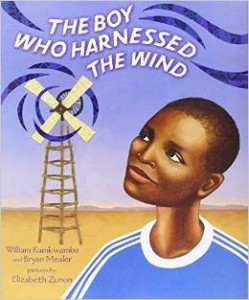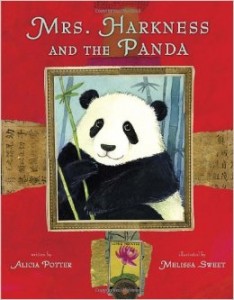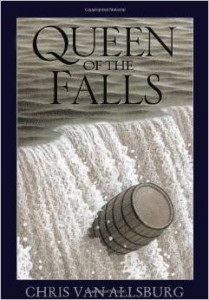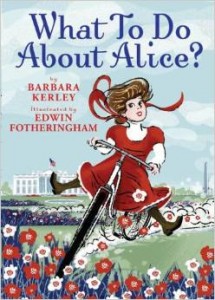As a panelist, we always discuss all books on their merits both literary and kid appeal. Sometimes, librarians find picture book biographies to be a tough sell. Not me! I am fortunate in my school to have the opportunity to collaborate with some amazing classroom, special education, and special area teachers. The third grade team at my school has created a wax museum biography project that students gear up for all year! Second graders visit the wax museum (along with what feels like half our town’s population) and so they start planning who they might research the following year. Often the students read chapter book biographies such as those from the popular “Who Was” series. But I take the opportunity to introduce them to a host of new friends via our burgeoning picture book biography section. Below are a few of the selections my students and I have loved from the CYBILS nominees, finalists, and winners. During these lessons, I point out the bibliographies included in many of these books and we dive into creating our own works cited pages to accompany their books of choice. We also research some of these figures using our subscription databases and discuss how to cite electronic sources. Collaborating on classroom projects makes embedding these types of skills all the more meaningful to our students.
 A Boy and A Jaguar, by Alan Rabinowitz; illustrated by Catia Chien: With testimonials from the illustrious Sy Montgomery and Temple Grandin, Alan Rabinowitz’s “A Boy and A Jaguar” delivers a story unlike any other I have read before. In the opening of the story, young Alan explains his own experience in school as a stutterer. My heart breaks for him. I know him. (Not Alan, but children who have difficulty for any number of reasons expressing themselves). But animals, he can talk to animals. Without stuttering or struggling. And he promises that he will speak for them if he gets the opportunity. As an adult, Dr. Rabinowitz works to preserve lands for wildlife, and jaguars in Belize specifically. There is a beautiful spread with illustrations from Catia Chien that literally takes my breath away. It reads: “In this animals eyes are strength and power and sureness of purpose. We are both whole. We are both at home.” In the About the Author section, we learn more about Dr. Rabinowitz and his work with Panthera, a nonprofit dedicated to protecting wildcats. He is also an advocate for stutterers and states that “he feels lucky to have been given the gift of stuttering and believes that had he not stuttered, he would not be on the path of his passion…” I love that.
A Boy and A Jaguar, by Alan Rabinowitz; illustrated by Catia Chien: With testimonials from the illustrious Sy Montgomery and Temple Grandin, Alan Rabinowitz’s “A Boy and A Jaguar” delivers a story unlike any other I have read before. In the opening of the story, young Alan explains his own experience in school as a stutterer. My heart breaks for him. I know him. (Not Alan, but children who have difficulty for any number of reasons expressing themselves). But animals, he can talk to animals. Without stuttering or struggling. And he promises that he will speak for them if he gets the opportunity. As an adult, Dr. Rabinowitz works to preserve lands for wildlife, and jaguars in Belize specifically. There is a beautiful spread with illustrations from Catia Chien that literally takes my breath away. It reads: “In this animals eyes are strength and power and sureness of purpose. We are both whole. We are both at home.” In the About the Author section, we learn more about Dr. Rabinowitz and his work with Panthera, a nonprofit dedicated to protecting wildcats. He is also an advocate for stutterers and states that “he feels lucky to have been given the gift of stuttering and believes that had he not stuttered, he would not be on the path of his passion…” I love that.
The Boy Who Loved Math, by Deborah Heiligman; illustrated by LeUyen Pham: Perhaps you have heard of “six degrees of separation” or “six degrees of Kevin Bacon,” but what is your Erdos number? Mathematicians prefer to measure their distance from the famous Paul Erdos, either by working with him directly (he worked with a LOT of people) or by working with someone who worked with him. Children will relate to the story of a young boy who didn’t always do as he was told. But only because he wanted to do math. Math, math, and more math. So much so that there was no time for learning to dress himself, butter his bread, or tie his own shoes. But boy, could he do math! Through his life, he continued on as a mathematical nomad, visiting and working with others who put him up in their homes and fed him in order to have the opportunity to work with him. And if his brain was awake, so was his host. Paul did math 19 hours a day, every day. The Boy Who Loved Math provides an obvious opportunity for introduction to the concept of prime numbers. Make sure not to skip the Note from the Illustrator. LeUyen Pham cut no corners embedding Erdos’ math onto every page. And the Note from the Author gives such interesting back matter about Paul Erdos and points out this is a truly unique book, the first of its kind for epsilons (children).
 The Boy Who Harnessed the Wind, by Wiliam Kamkwamba and Bryan Mealer; illustrated by Elizabeth Zunon: This is stunning, in my opinion. The writing is lyrical and the illustrations capture my interest. But let’s begin at the beginning, shall we. The Boy Who Harnessed the Wind, written by William Kamkwamba and Bryan Mealer and illustrated by Elizabeth Zunon, is the story of author William Kamkwamba and his family and the community struggles with drought and famine in Malawi. As a result, Kamkwamba finds himself unable to attend school but instead turning to the library for answers to some burning questions like how an engine of a car works. A natural engineer, he happens upon information and pictures of windmills and sets out to harness the wind himself. The remarkable illustrated tale is followed by further information about William Kamkwamba’s journey including a TED talk in Tanzania. Included in information about the author is a link to more information about The Moving Windmills Project, something I plan to learn more about.
The Boy Who Harnessed the Wind, by Wiliam Kamkwamba and Bryan Mealer; illustrated by Elizabeth Zunon: This is stunning, in my opinion. The writing is lyrical and the illustrations capture my interest. But let’s begin at the beginning, shall we. The Boy Who Harnessed the Wind, written by William Kamkwamba and Bryan Mealer and illustrated by Elizabeth Zunon, is the story of author William Kamkwamba and his family and the community struggles with drought and famine in Malawi. As a result, Kamkwamba finds himself unable to attend school but instead turning to the library for answers to some burning questions like how an engine of a car works. A natural engineer, he happens upon information and pictures of windmills and sets out to harness the wind himself. The remarkable illustrated tale is followed by further information about William Kamkwamba’s journey including a TED talk in Tanzania. Included in information about the author is a link to more information about The Moving Windmills Project, something I plan to learn more about.
 Dave the Potter, by Laban Carrick Hill; illustrated by Bryan Collier: I have long used Dave the Potter during our study of Caldecott Medal and Honor winners, specifically during Black History Month and to coincide with Second Grade’s ceramics unit in Art Class. That’s what I like to call 2 (3, 4…) Birds with One Stone. Oh, and did I mention it’s amazing during April ~ National Poetry Month? Dave’s story is captivating in that his experience is very different from that of slaves who worked the fields. And yet. He is still a slave. And still a rebellious slave. Thank goodness. Without his rebellion, we wouldn’t have his words preserved even now. While we don’t know how he learned to read and write, we do know that he did and we know that it was dangerous, at that time, for him to do so. I am struck by Bryan Collier’s illustrations, the hidden words “Live Life” on the side of the barn, the family tree reaching up to the sun, gorgeous.
Dave the Potter, by Laban Carrick Hill; illustrated by Bryan Collier: I have long used Dave the Potter during our study of Caldecott Medal and Honor winners, specifically during Black History Month and to coincide with Second Grade’s ceramics unit in Art Class. That’s what I like to call 2 (3, 4…) Birds with One Stone. Oh, and did I mention it’s amazing during April ~ National Poetry Month? Dave’s story is captivating in that his experience is very different from that of slaves who worked the fields. And yet. He is still a slave. And still a rebellious slave. Thank goodness. Without his rebellion, we wouldn’t have his words preserved even now. While we don’t know how he learned to read and write, we do know that he did and we know that it was dangerous, at that time, for him to do so. I am struck by Bryan Collier’s illustrations, the hidden words “Live Life” on the side of the barn, the family tree reaching up to the sun, gorgeous.
 Francis and Eddie: The True Story of America’s Underdogs, by Brad Herzog; illustrated by Zak Pullen: When I started to read “Francis and Eddie,” I was reminded of a movie, “The Greatest Game Ever Played.” I quickly realized that was because the stories were one and the same. Always read the book first. Always. But know that scenes from this movie may offer students another insight into the story. Or perhaps this video of Francis and Eddie 50 years after the historic game. Or perhaps this one which encapsulates their experience from the 1913 game. Zak Pullen focuses throughout on the characters, and their emotions as they hold a tie with the world renowned leaders of golf.
Francis and Eddie: The True Story of America’s Underdogs, by Brad Herzog; illustrated by Zak Pullen: When I started to read “Francis and Eddie,” I was reminded of a movie, “The Greatest Game Ever Played.” I quickly realized that was because the stories were one and the same. Always read the book first. Always. But know that scenes from this movie may offer students another insight into the story. Or perhaps this video of Francis and Eddie 50 years after the historic game. Or perhaps this one which encapsulates their experience from the 1913 game. Zak Pullen focuses throughout on the characters, and their emotions as they hold a tie with the world renowned leaders of golf.
 Mrs. Harkness and the Panda, by Alicia Potter; illustrated by Melissa Sweet: Once again, a story unknown to me is always going to be a favorite. The story of Ruth Harkness and her eventual and lengthy and painstaking search for a panda, the first to be brought to the US is in one word…incredible. Melissa Sweet’s illustrations and use of authentic material and textures from China enhance an extraordinary story. Something that struck me about the story is the timeline itself. Not to give too much away, but Ruth Harkness married at the age of 34, which in 1934 I would imagine, would be considered sort of old to be getting married. She also got married to a man she’d been friends with for ten years. A lengthy courtship. And then, a mere 23 DAYS later, her newlywed husband left for an expedition to China and…died. What a tragic beginning. Also, looking at the handy dandy timeline, or as Alicia Potter terms it “Chronology of Events,” Ruth Harkness was able to accomplish in approximately 4 months what her husband was unable to do in 2 years. Not an explorer. Hah! Ruth Harkness sure did prove a few folks wrong! And her forethought to bring a bottle to feed a baby panda. Smart! Now, this story is perfect for a read aloud with students. It’s engaging, but not too long, not too heavy on information. On the same token, if a students needs enough information on Ruth Harkness to, for example, write a report, this book will not provide enough depth. With that said, I LOVE it. I love the illustrations, I love the story. I love it. And it leaves me wanting more.
Mrs. Harkness and the Panda, by Alicia Potter; illustrated by Melissa Sweet: Once again, a story unknown to me is always going to be a favorite. The story of Ruth Harkness and her eventual and lengthy and painstaking search for a panda, the first to be brought to the US is in one word…incredible. Melissa Sweet’s illustrations and use of authentic material and textures from China enhance an extraordinary story. Something that struck me about the story is the timeline itself. Not to give too much away, but Ruth Harkness married at the age of 34, which in 1934 I would imagine, would be considered sort of old to be getting married. She also got married to a man she’d been friends with for ten years. A lengthy courtship. And then, a mere 23 DAYS later, her newlywed husband left for an expedition to China and…died. What a tragic beginning. Also, looking at the handy dandy timeline, or as Alicia Potter terms it “Chronology of Events,” Ruth Harkness was able to accomplish in approximately 4 months what her husband was unable to do in 2 years. Not an explorer. Hah! Ruth Harkness sure did prove a few folks wrong! And her forethought to bring a bottle to feed a baby panda. Smart! Now, this story is perfect for a read aloud with students. It’s engaging, but not too long, not too heavy on information. On the same token, if a students needs enough information on Ruth Harkness to, for example, write a report, this book will not provide enough depth. With that said, I LOVE it. I love the illustrations, I love the story. I love it. And it leaves me wanting more.
 The Noisy Paint Box, by Barb Rosenstock; illustrated by Mary Grandpre: I love this story, and the illustrations and the beautiful orchestra of words and colors. The first three illustrations do a fantastic job of showing just how boooooored Kandinsky was with his lessons, how drab life was before paints enter the picture. Look at the details. Kandinsky droops just like the candles. And he seems bored by adult conversation in equal measure to the dead fish with eyes rolled up in similar fashion. But the paint box bursting with beautiful music to Vasya’s ears woke him up to the world. But, he lived at a time that was not yet ready for his art. His aunt insisted upon proper art classes. And Vasya conformed to his expectations both in art and his parent’s plans for his life. To be a lawyer. Boring. Until, one day. Prior to reading, we did a pre-reading activity discussing the five senses and then I introduced the neurological phenomenon known as synesthesia. Wassily Kandinsky is now known to have experienced synesthesia of four senses: sight (colors), hearing, touch, and smell. What resulted was a pretty fantastic artistic career as one of the forerunners of abstract art. Barb Rosenstock’s storytelling is beautiful and the repetition of the questions Vasya may have been asked pertinent to his are are memorable for even the youngest reader. Mary Grandpre (well known for her cover and interior art in the Harry Potter series) does a masterful job of painting the painter’s world.
The Noisy Paint Box, by Barb Rosenstock; illustrated by Mary Grandpre: I love this story, and the illustrations and the beautiful orchestra of words and colors. The first three illustrations do a fantastic job of showing just how boooooored Kandinsky was with his lessons, how drab life was before paints enter the picture. Look at the details. Kandinsky droops just like the candles. And he seems bored by adult conversation in equal measure to the dead fish with eyes rolled up in similar fashion. But the paint box bursting with beautiful music to Vasya’s ears woke him up to the world. But, he lived at a time that was not yet ready for his art. His aunt insisted upon proper art classes. And Vasya conformed to his expectations both in art and his parent’s plans for his life. To be a lawyer. Boring. Until, one day. Prior to reading, we did a pre-reading activity discussing the five senses and then I introduced the neurological phenomenon known as synesthesia. Wassily Kandinsky is now known to have experienced synesthesia of four senses: sight (colors), hearing, touch, and smell. What resulted was a pretty fantastic artistic career as one of the forerunners of abstract art. Barb Rosenstock’s storytelling is beautiful and the repetition of the questions Vasya may have been asked pertinent to his are are memorable for even the youngest reader. Mary Grandpre (well known for her cover and interior art in the Harry Potter series) does a masterful job of painting the painter’s world.
 A Splash of Red, by Jen Bryant; illustrated by Melissa Sweet: Beyond the third grade biography unit, this book lends itself well to my school’s penchant for books about famous Pennsylvanians. Fourth graders engage in a study of Pennsylvania, traveling to Lancaster in the spring and weaving this study into areas of Language Arts, Social Studies, and Science. Our art teacher has embedded a study of Pittsburgh artist, Andy Warhol, but now we have another artist to who we can take a closer look because Horace Pippin was born in West Chester, PA. With fourth graders, I researched other famous artists and scientists from Pennsylvania who (I’m pretty sure) our students have never heard of, cross checking our subscription databases to ensure there are articles with information and fourth graders will be practicing utilizing and citing their sources using both Encyclopedia Brittanica and World Book Encyclopedia. On to the book. I have a soft spot for everything Melissa Sweet and she does not disappoint. Her illustrations are always colorful, but she pays careful attention to her own splashes of red, which Pippin became well known for, throughout the story. Jen Bryant paints her inspirational story in words that flow from one page to the next. An interesting follow up activity might be to have students use their non-dominant hand to grasp the other and write or create their own paintings. With a splash of red, of course.
A Splash of Red, by Jen Bryant; illustrated by Melissa Sweet: Beyond the third grade biography unit, this book lends itself well to my school’s penchant for books about famous Pennsylvanians. Fourth graders engage in a study of Pennsylvania, traveling to Lancaster in the spring and weaving this study into areas of Language Arts, Social Studies, and Science. Our art teacher has embedded a study of Pittsburgh artist, Andy Warhol, but now we have another artist to who we can take a closer look because Horace Pippin was born in West Chester, PA. With fourth graders, I researched other famous artists and scientists from Pennsylvania who (I’m pretty sure) our students have never heard of, cross checking our subscription databases to ensure there are articles with information and fourth graders will be practicing utilizing and citing their sources using both Encyclopedia Brittanica and World Book Encyclopedia. On to the book. I have a soft spot for everything Melissa Sweet and she does not disappoint. Her illustrations are always colorful, but she pays careful attention to her own splashes of red, which Pippin became well known for, throughout the story. Jen Bryant paints her inspirational story in words that flow from one page to the next. An interesting follow up activity might be to have students use their non-dominant hand to grasp the other and write or create their own paintings. With a splash of red, of course.
 Queen of the Falls, by Chris VanAllsbug: Have you ever heard of Annie Edson Taylor? I hadn’t either. And neither had Chris Van Allsburg. Which is why he wrote this book when he read that she was not only the first woman but the first person to take a barrel ride over Niagara Falls. To be fair, the names of the other barrel riders are in the Author’s Note and I didn’t know their names either. Much like his fantastical tales, Annie’s story is almost too good to be true. But it IS true. What is interesting to me is that people on the lecture tour and carnival routes were LESS interested when they learned how old Annie was. I think that is more to her credit than detriment. A good companion to this read would be Mordicai Gerstein’s Caldecott medal winning “The Man Who Walked Between the Towers.” Likewise, curricular connections can be made with a state study, looking at impressive landmarks throughout the US and Canada.
Queen of the Falls, by Chris VanAllsbug: Have you ever heard of Annie Edson Taylor? I hadn’t either. And neither had Chris Van Allsburg. Which is why he wrote this book when he read that she was not only the first woman but the first person to take a barrel ride over Niagara Falls. To be fair, the names of the other barrel riders are in the Author’s Note and I didn’t know their names either. Much like his fantastical tales, Annie’s story is almost too good to be true. But it IS true. What is interesting to me is that people on the lecture tour and carnival routes were LESS interested when they learned how old Annie was. I think that is more to her credit than detriment. A good companion to this read would be Mordicai Gerstein’s Caldecott medal winning “The Man Who Walked Between the Towers.” Likewise, curricular connections can be made with a state study, looking at impressive landmarks throughout the US and Canada.
 What To Do About Alice, by Barbara Kerley; illustrated by Edwin Fotheringham: When thinking about incorporating this true tale of a life well lived into our curriculum at school, I think it lends itself to discussion of the governmental system, a study of our presidents, or a map study as Alice trotted the globe from Cuba to Puerto Rico, Hawaii, Japan, the Phillipines, and China. Barbara Kerley does a lovely job of highlighting Alice’s antics and Edwin Fotheringham’s illustrations really bring life. We can see how exhausted and exasperated Theodore Roosevelt was when Alice was eating up the world, his beads of sweat and side eye a bit of a tip off. Alice’s vim and vigor are clear with a confident chin up whatever she was doing, a broad smile (unless, of course, the suggestion was to attend boarding school) and a skip in her step all over the world. Looking to pair this with another daring picture book? Check out Daredevil: The Daring Life of Betty Skelton by Meghan McCarthy.
What To Do About Alice, by Barbara Kerley; illustrated by Edwin Fotheringham: When thinking about incorporating this true tale of a life well lived into our curriculum at school, I think it lends itself to discussion of the governmental system, a study of our presidents, or a map study as Alice trotted the globe from Cuba to Puerto Rico, Hawaii, Japan, the Phillipines, and China. Barbara Kerley does a lovely job of highlighting Alice’s antics and Edwin Fotheringham’s illustrations really bring life. We can see how exhausted and exasperated Theodore Roosevelt was when Alice was eating up the world, his beads of sweat and side eye a bit of a tip off. Alice’s vim and vigor are clear with a confident chin up whatever she was doing, a broad smile (unless, of course, the suggestion was to attend boarding school) and a skip in her step all over the world. Looking to pair this with another daring picture book? Check out Daredevil: The Daring Life of Betty Skelton by Meghan McCarthy.
— Ellen Zschunke, On the Shelf 4 Kids

